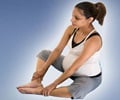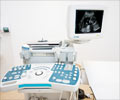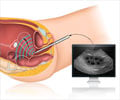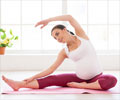- Exercise during Pregnancy - (https://www.acog.org/womens-health/faqs/exercise-during-pregnancy)
- Cooper, D. B., & Yang, L. (2022). Pregnancy And Exercise. In StatPearls. StatPearls Publishing. - (https://www.ncbi.nlm.nih.gov/books/NBK430821/)
- Physical Activity and Exercise During Pregnancy and the Postpartum Period - (https://www.acog.org/clinical/clinical-guidance/committee-opinion/articles/2020/04/physical-activity-and-exercise-during-pregnancy-and-the-postpartum-period)
- Tailor Sit, Trunk Turn for Back Pain During Pregnancy - (https://www.fairview.org/Patient-Education/Articles/English/t/a/i/l/o/Tailor_Sit_Trunk_Turn_for_Back_Pain_During_Pregnancy_85678)
- Exercise During Pregnancy - (https://my.clevelandclinic.org/health/articles/6914-exercise-during-pregnancy)
- Mueller, S. M., & Grunwald, M. (2021). Effects, Side Effects and Contraindications of Relaxation Massage during Pregnancy: A Systematic Review of Randomized Controlled Trials. Journal of clinical medicine, 10(16), 3485. - (https://doi.org/10.3390/jcm10163485)
- Massage and Pregnancy: A Powerful Combination - (https://www.amtamassage.org/publications/massage-therapy-journal/massage-and-pregnancy-a-powerful-combination/)
Introduction
God’s interest in the human race is nowhere better evinced than in obstetrics. ~ Martin H. Fischer
Pregnancy is a significant period in a woman’s life, marking her momentous journey into motherhood with immense changes taking place in her mind and body, as the fetus develops into a full-grown baby.
Backed by years of research, nutritious food, rest, and exercise are crucial for expectant women. According to the American College of Obstetricians and Gynecologists (ACOG), pregnant women who are free from any form of obstetric complications should engage in at least 30 minutes of moderate-intensity exercise, 5-6 days a week. One can also perform bouts of 10 minutes workouts throughout the day(1✔ ✔Trusted Source
Exercise during Pregnancy
Go to source).
Pregnant women must seek clearance from their doctors or a certified prenatal fitness expert before taking up any form of exercise.
Lack of exercise in expectant women could result in the reduction of muscular and cardiovascular fitness, weight gain, back pain, increased risk of pregnancy-related complications, stillbirth, abortions, and deep vein thrombosis.
Nature of Exercise
Exercises that impart benefits in pregnancy are low-impact aerobics, calisthenics, slow gymnastic movements specially tailored for pregnancy, Kegel exercises, yoga, and relaxation techniques. When regular exercise is practiced from the prenatal period it is advisable to continue the same regimen but with modifications in intensity(2✔ ✔Trusted Source
Cooper, D. B., & Yang, L. (2022). Pregnancy And Exercise. In StatPearls. StatPearls Publishing.
Go to source).
Aerobic exercises like walking, cycling, elliptical, stair steppers, swimming, yoga, and aerobic dancing can be performed. Cycling on a stationary bike is advisable to prevent falls and could be more comfortable than walking as it may strain the pelvis. Swimming is an excellent exercise for women with joint pain(2✔ ✔Trusted Source
Cooper, D. B., & Yang, L. (2022). Pregnancy And Exercise. In StatPearls. StatPearls Publishing.
Go to source).
Cooper, D. B., & Yang, L. (2022). Pregnancy And Exercise. In StatPearls. StatPearls Publishing.
Go to source).
Exercises of concern for an expectant mother would be playing sports that might cause injury (like soccer, basketball, hockey, or horseback riding), skiing, scuba diving, skydiving, heavy weightlifting, gymnastics, and long-distance running(2✔ ✔Trusted Source
Cooper, D. B., & Yang, L. (2022). Pregnancy And Exercise. In StatPearls. StatPearls Publishing.
Go to source).
Warning Signs to Discontinue Exercising
- Abdominal pain
- Regular painful contractions
- Dizziness
- Headache
- Calf swelling or pain
- Amniotic fluid leakage
- Vaginal bleeding(3✔ ✔Trusted Source
Physical Activity and Exercise During Pregnancy and the Postpartum Period
Go to source)
Benefits of Exercise
The benefits of prenatal exercise are immense for the expectant woman and the fetus during pregnancy and childbirth.

During pregnancy:
- Reduces risk of miscarriage by 40%
- Promotes good sleep
- Enhances energy levels
- Reduces risks of premature labor, gestational diabetes, and pregnancy-induced hypertension
- Reduces lower back pain
- Reduces loss of bone density during lactation
- Improves bowel movement
- Improves flexibility of joints and muscles
- Higher incidence of vaginal delivery
During labor:
- Increases the level of endorphins and downsizes the need for epidurals. During labor, there is a gush of endorphins in the woman’s body to help her deal with the pain of uterine contractions.
- Reduces the incidences of Cesarean sections.
For the fetus:
- Consistent exercise enhances the growth of the placenta; it was observed that the placenta of women who exercised showed at least 15% more blood vessels at full term.
- Reduces levels of stress hormones, thereby helping produce healthier babies.
- Aids in their intellectual capacity.
Contraindications for Exercise During Pregnancy
Exercising may be favorable to the health of the pregnant mother. However, certain contraindications that may warrant abandoning the exercise program are:
- Pregnancy-induced hypertension
- Pre-term rupture of membranes
- Pre-term labor during the prior or current pregnancy
- Incompetent cervix or cerclage placement
- Persistent second or third trimester bleeding
- Placenta previa
- Intrauterine growth retardation and
- Health complications like cardiac disease, pulmonary disease, thyroid dysfunction, and hypertension.
Get Fit to Deliver – 7 Easy Exercises
The exercises detailed in this section will help improve circulation in the pelvic region, strengthen the thigh muscles, and increase flexibility in the joints.

1. Tailor Sitting
- Adopt a sitting position on the floor with the soles of your feet together by bending at the knees. Pull your feet as close to your groin as possible, without trying too hard and keeping comfort in mind.
- Open out your thighs and lower the knees to touch the floor.
- Take a deep breath - breathe in by lifting your spine while keeping the pelvis touching the floor and breathing out.
2. Trunk Turns
- Make yourself comfortable on the floor with your legs crossed and your back straight.
- Keep the left hand on the right knee and the right hand on the floor.
- Slowly twist towards the right starting from the head, shoulders, and then the chest as far as you can.
- Remember to keep the hips, knees, and feet in place.
- Hold the position for 5 counts and swap sides to repeat the same(4✔ ✔Trusted Source
Tailor Sit, Trunk Turn for Back Pain During Pregnancy
Go to source).
3. Squatting
- In a standing position, keeping the back straight, spread your feet to shoulder width.
- Squat low to the extent possible without pushing yourself too much. Hold hands out for balance.
- Hold the squat for a few seconds.
- Come forward, kneel and then stand up.
4. Kegel Exercises
Kegel exercises involve working out the pelvic floor muscles to strengthen them and aid in better control of urination. During delivery, these exercises increase the woman’s ability to push as per the instructions of the specialist. Kegel exercises can be performed at any time, place, or position.
Steps:
- Tighten and relax the pelvic floor muscles alternatively.
- Hold it for 10 seconds and relax. 1 set of Kegel exercises includes 15 repetitions.
To identify the pelvic floor muscles, during urination, stop the flow of urine midstream. Care must be taken not to contract the abdominal, thigh, or buttock muscles.
5. Stretching Exercises
Stretching exercises like neck rotation, shoulder rotation, leg shakes, ankle rotation, and thigh shift help to warm up and strengthen the muscles. These exercises can be performed along with other exercises discussed(5✔ ✔Trusted Source
Exercise During Pregnancy
Go to source).
6. Relaxation Techniques
Expectant women experience a range of emotions as they prepare themselves for the big day. To ease nerves, breathing and relaxation techniques are a blessing during pregnancy.
7. Breathing
Tension and anxiety during pregnancy may cause shallow breathing. Breathing may also become rapid. This increases the metabolic rate causing a reduction in the intake of oxygen. On the contrary, breathing deeply and rhythmically during pregnancy can reduce muscle tension, maintain heart rate, increase oxygen levels, reduce stress, ensure good sleep and reduce anxiety and pain associated with labor.
Steps to develop breathing awareness
- Sit or lie in a comfortable position.
- Keeping the mouth closed, take a deep slow breath through the nose. Experience the rise of the stomach as the diaphragm and lungs fill with air. Hold the breath for a second and exhale through the nose to the count of four.
As pregnancy progresses, lying on the back may not be a great idea propping legs up on a chair or using pillows beneath legs can be helpful.
Massage Your Way to Relaxation
Massages can be the best gift for pregnant women as it helps relieve stress, anxiety, depression, back pain, and leg pain. It also helps boost immunity, serotonin, and dopamine production, and reduces the risk of preterm delivery(6✔ ✔Trusted Source
Mueller, S. M., & Grunwald, M. (2021). Effects, Side Effects and Contraindications of Relaxation Massage during Pregnancy: A Systematic Review of Randomized Controlled Trials. Journal of clinical medicine, 10(16), 3485.
Go to source). It can also improve circulation, and soothe tired muscles, while also activating the nerve endings in the skin. Massaging is also known to be beneficial for morning sickness and heartburn, the highly common issues in pregnancy(7✔ ✔Trusted Source
Massage and Pregnancy: A Powerful Combination
Go to source). Exerting too much pressure may prove harmful.
Scented or aromatic oils are used during massages to enable hands to glide over the skin. Oils like lavender, rose, neroli, clary sage, geranium, and nutmeg help improve blood circulation and relieve insomnia and headache.

Massage Movements
Different strokes are used for massage to enable appropriate relaxation and relief. The massage movements that can be helpful are:
Circling: Strokes are circularly made in one direction, using the palms of both hands, keeping the movement away from the spine. Do not exert too much pressure while massaging the abdomen and breasts.
Effleurage: Slight feathery circular massage movements made using the tips of fingers. These massage movements are safe all through pregnancy and can be used all over the abdomen.
Gliding: Palms of both hands are used to and fro, down the sides of the body in a gliding motion without exerting the weight of the body on the hands.
Self-Massaging Techniques
Using smooth circular movements, massage your hips and thighs. Massages on the forehead, chin, and neck can also be done. Gentle pinching movements along the jaw bone and around the neck improve blood circulation in the neck region.
Massage by a Partner
Getting your partner to give you a foot, hand, or neck massage before bed is a good way to enhance relaxation and promote a sense of security and closeness with your partner. Forehead massage involving circular movements and forehead presses can be soothing. Gentle lower back massages can ease discomfort and pain.
Women who have high blood pressure, increased risks for pre-eclampsia or congenital heart disease, or have undergone surgery or organ transplant recently should consult the doctor before opting for massages.
An active lifestyle with regular exercise, a relaxed mind, and constant support from the partner and society beautifully shape a healthy pregnancy journey for an expecting mother.


















